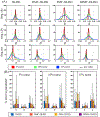Assessing the identifiability of model selection frameworks for the prediction of patient outcomes in the clinical breast cancer setting
- PMID: 40777981
- PMCID: PMC12330887
- DOI: 10.1016/j.jocs.2023.102006
Assessing the identifiability of model selection frameworks for the prediction of patient outcomes in the clinical breast cancer setting
Abstract
We develop a family of mathematical models to predict patient-specific response to neoadjuvant therapy in breast cancer. The models capture key features of tumor growth, therapeutic response, and tissue mechanics that are informed by diffusion weighted and dynamic contrast-enhanced magnetic resonance imaging. We then calibrate the models to synthetic and clinical data using Bayesian inference to give a description of the parameter uncertainties. Given the family of models and the calibration scheme, we perform three analyses. First, we test the identifiability of each model; that is, given synthetic data with the same level of noise as that seen in the clinical setting, are we able to accurately recover parameter values employed to generate the data? Second, we test the identifiability of the framework itself; that is, when data is generated by one model from the family, is that model selected as the best one during the calibration? Third, we apply our model family to predict patient-specific response on a cohort of 32 patients with triple negative breast cancer. For analysis 1, we show that we can recover the parameters used to generate synthetic data (with 5%, 10%, and 15% Gaussian noise - greater than that typically seen in magnetic resonance imaging in the clinical setting) with a mean error of 5.9% (+/-1.4%). For analysis 2, the model used to generate the data is selected as the best model for over 50% of the synthetic data sets, provided that the noise level in the synthetic data is less than 10%. For analysis 3, we show that the calibrated drug efficacy rate in the diffusion and proliferation mechanically coupled, drug informed, reaction diffusion model strongly correlates with patient response to therapy with an area under the curve score of 0.85 in a receiver operator characteristic analysis. Thus, our framework shows that, within the noise levels encountered in the clinical setting, a high level of rigor can be achieved for mathematical model parameterizations and selections, and this translates into high accuracy for predicting responders and non-responders to neoadjuvant therapy.
Keywords: Bayesian inference; Computational Oncology; Image-based modelling; Model selection.
Figures







Similar articles
-
Comparison of Two Modern Survival Prediction Tools, SORG-MLA and METSSS, in Patients With Symptomatic Long-bone Metastases Who Underwent Local Treatment With Surgery Followed by Radiotherapy and With Radiotherapy Alone.Clin Orthop Relat Res. 2024 Dec 1;482(12):2193-2208. doi: 10.1097/CORR.0000000000003185. Epub 2024 Jul 23. Clin Orthop Relat Res. 2024. PMID: 39051924
-
A New Measure of Quantified Social Health Is Associated With Levels of Discomfort, Capability, and Mental and General Health Among Patients Seeking Musculoskeletal Specialty Care.Clin Orthop Relat Res. 2025 Apr 1;483(4):647-663. doi: 10.1097/CORR.0000000000003394. Epub 2025 Feb 5. Clin Orthop Relat Res. 2025. PMID: 39915110
-
Cost-effectiveness of using prognostic information to select women with breast cancer for adjuvant systemic therapy.Health Technol Assess. 2006 Sep;10(34):iii-iv, ix-xi, 1-204. doi: 10.3310/hta10340. Health Technol Assess. 2006. PMID: 16959170
-
Short-Term Memory Impairment.2024 Jun 8. In: StatPearls [Internet]. Treasure Island (FL): StatPearls Publishing; 2025 Jan–. 2024 Jun 8. In: StatPearls [Internet]. Treasure Island (FL): StatPearls Publishing; 2025 Jan–. PMID: 31424720 Free Books & Documents.
-
Carbon dioxide detection for diagnosis of inadvertent respiratory tract placement of enterogastric tubes in children.Cochrane Database Syst Rev. 2025 Feb 19;2(2):CD011196. doi: 10.1002/14651858.CD011196.pub2. Cochrane Database Syst Rev. 2025. PMID: 39968844
Cited by
-
Predictive Digital Twins with Quantified Uncertainty for Patient-Specific Decision Making in Oncology.ArXiv [Preprint]. 2025 May 13:arXiv:2505.08927v1. ArXiv. 2025. PMID: 40463701 Free PMC article. Preprint.
-
Validating the predictions of mathematical models describing tumor growth and treatment response.ArXiv [Preprint]. 2025 Feb 26:arXiv:2502.19333v1. ArXiv. 2025. PMID: 40061122 Free PMC article. Preprint.
References
-
- Yankeelov TE, Peterson TE, Abramson RG, Garcia-Izquierdo D, Arlinghaus LR, Li X, Atuegwu NC, Catana C, Manning HC, Fayad ZA, Gore JC, Simultaneous pet-mri in oncology: a solution looking for a problem?, Magnetic Resonance Imaging 30 (9) (2012) 1342–1356. doi: 10.1016/j.mri.2012.06.001. - DOI - PMC - PubMed
-
- Weis JA, Miga MI, Arlinghaus LR, Li X, Abramson V, Chakravarthy AB, Pendyala P, Yankeelov TE, Predicting the response of breast cancer to neoadjuvant therapy using a mechanically coupled reaction-diffusion model, Cancer Research 75 (2015) 4697–4707. doi: 10.1158/0008-5472.CAN-14-2945. - DOI - PMC - PubMed
Grants and funding
LinkOut - more resources
Full Text Sources
